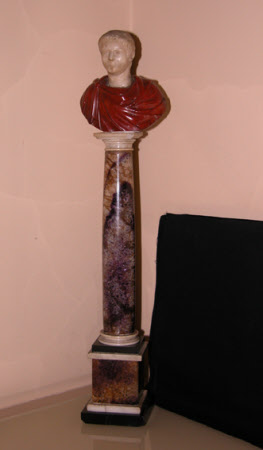Bust of Caligula
Category
Art / Sculpture
Date
circa 1750 - circa 1800
Materials
Marble and jasper, set on a Blue John and white marble column
Measurements
137 x 117.5 x 68 mm
Place of origin
Italy
Order this imageCollection
Anglesey Abbey, Cambridgeshire
NT 516585
Summary
Marble and jasper on a Blue John and white marble column, bust of a Roman emperor, probably Caligula (A.D. 12-41, reigned 37-41), probably Italian and British, c.1750-1800. A small sculpted bust of a Roman emperor, probably the Emperor Caligula. The head is made of marble and the bust of jasper, set on a Blue John column with white marble capital and rings, on a rectangular base. The bust was probably made in Italy, in the second half 18th century, and mounted on column in England. The column is broken at the top, below the capital, whilst the separately-carved head of the Emperor is all but detached from the bust. This is a typical example of the sort of small classical portrait busts, often of Roman emperors, made in large numbers in Italy for the Grand Tour market.
Full description
The little bust probably represents the Emperor Caligula (A.D. 12-41), the son of the general Germanicus and of Agrippina. Born Caius Caesar, he was brought up amongst the legions in Germany, where the legionary soldiers gave him the name by which he is popularly known, from his habit as a boy of wearing small caligae, or soldiers’ boots. Caligula gained the favour of Tiberius, whom he succeeded in AD 37. After being welcomed by the people with the greatest enthusiasm as the son of Germanicus, Caligula at first governed wisely and justly, however a sudden illness some eighteen months into his reign changed his character utterly, turning him into an unpredictable madman, notorious for his wild extravagance and tyrannical behaviour. Caligula extorted money throughout Rome and Italy and then marched into Gaul on a trail of naked plunder. He eventually arrived at the coast with his troops who, expecting to cross the Channel to invade Britain, were suddenly told by the Emperor to collect sea-shells, which he described as the spoils of conquered Ocean. Caligula was murdered in A.D. 41, shortly after his return to Rome. Jeremy Warren 2019
Provenance
Acquired 1932 by Urban Huttleston Rogers Broughton, 1st Lord Fairhaven (1896-1966); identifiable in an Anglesey Abbey inventory of 1932, p. 24, Living Room, valued at £15; identifiable in an Anglesey Abbey inventory of 1940, p.231, Small Study, valued at £15; bequeathed 1966 to the National Trust by Lord Fairhaven with the house and the rest of the contents.
Credit line
Anglesey Abbey, The Fairhaven Collection (The National Trust)
References
‘Anglesey Abbey, Lode, Cambridgeshire. An Inventory and Valuation of Furniture, Pictures, Ornamental Objects, Household Effects and A Collection of Miniatures.. prepared for Insurance Purposes’, Turner, Lord and Ransom, November 1932, p. 24 'Anglesey Abbey, Lode, Cambridgeshire. An Inventory and Valuation of Furniture, Books, Ornamental Items & Household Effects .. prepared for Insurance Purposes’, Turner, Lord and Ransom, April 1940, p. 231 Christie, Manson & Woods 1971: The National Trust, Anglesey Abbey, Cambridge. Inventory: Furniture, Textiles, Porcelain, Bronzes, Sculpture and Garden Ornaments’, 1971, p. 72, Secretary’s Room

